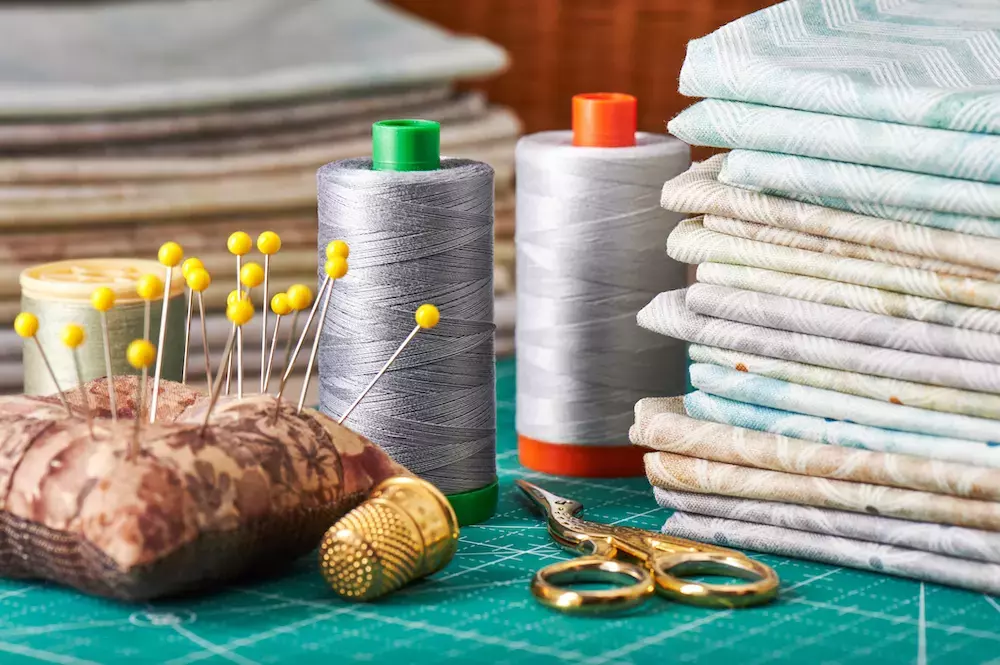How to Keep Your Quilting Space Organized
2020-06-08
Quilting, in itself, is about making order out of disorder. So when walking into a quilting studio or sewing room, it might seem as if there’s fabric tossed everywhere. Some of it may be hanging on the wall or thrown about on tables or even the floor. Then, there’s thread, bobbins, batting, and more. How could anyone keep all of this together and organize?
Well, we’re here to help! Here is how you can keep your quilting space nice and orderly, even when you are in the middle of a project:
Keep Your Common Tools On Hand
Your scissors, pins (and subsequent pin cushion), rotary cutters, mats, rulers, and ironing board should all be easy to access.
You can use bins or holders on a desk or keep them in a drawer under your sewing table. The point is, you shouldn’t have to get up and find any of these items. Your iron and ironing board are also good to keep out if you can manage the space!
Clear Your Workspace When You’re Done
Imagine, walking into your sewing space, and just pulling out your pattern and starting on your quilt. It may seem like a dream or an unattainable goal, but in reality, it isn't.
When you clear off your cutting and sewing spaces each time you are finished for the day, it means that there's no cleanup to do before you get started next time.
Collect Patterns in a Binder
Patterns are a lot of fun, and when you find a good one, you hold onto it. Many turn to Pinterest for new patterns, and you can’t always fight that urge to print them or keep quilting patterns you find in magazine magazines.
Store your patterns in Ziplock gallon size bags and then pierce those bags onto the prongs of a three-ring binder.
Use dividers to separate patterns by jelly roll quilts, fat quarter patterns, baby quilts, and more.
Label, Label, Label
Label boxes, bags, bins, drawers, and even little bags; label everything! If you can identify something without opening it, then you’ll save tons of time when searching. You don’t need a label maker; you can use stickers, or even post-its until you find the system works for you.
Separate Your Fabric by Size and Stash
Every sewer has that stash of misshapen fabric and scraps lying around. Will they part with it? Not willingly.
It's nearly impossible to organize a genuine fabric scrap stash, but these scraps can often make a quilt unique. One way to sort them is by color or pattern. The florals can be folded together, and everything else folded by color. That way, when you want something in red or pink, you can grab the bundle and keep on quilting.
Your scraps won't be the only additional fabric you have lying around. This includes the fabric you fell in love with at the store or bought on sale without already having a genuine pre-planned purpose. You can sort this fabric by size and color. If you have two or more yards of a fabric, then keep that separate from the bits that are only one-yard.
Fat quarters, charm packs, and similar items do very well in cubbies. Usually, they're already in complementary patterns and shades, which resolves the need to separate by color or pattern.
If Something Doesn’t Work – Change It
We all get to that point when we realize we could have organized something better. Don't fret. Organizing is an ongoing job, not a one-and-done situation.
If you know that you're pulling out different patterns constantly, then bring those patterns closer to your workspace.
Additionally, if you're working on a project that calls for particular tools, then keep those nearby as well.
New storage plans don't mean you did it wrong the first time; it just means you need to make a quick tweak to your system.
Go Through Your Supplies Regularly
Sewing supplies, and fabric especially, build up quickly. Every three or four months, sort through your supply to see what you can unload. There are many charities that will accept craft donations, or you could quickly burn through scrap material and donate goods such as face masks, stuffed animals, hand towels, and more.
In the end, if you’re not using something, and have no plans for it, then someone else could use it. This includes notions and equipment of all sizes. Who needs two sewing machines? Some do, but most don’t, and you can donate that old machine or take it to a thrift shop. Donating and selling supplies is a great way to make them accessible to others rather than collecting dust in your sewing room. It is also a great way to clean up your space, keep your area organized, and make more room.
By keeping your quilting space clean and organized, you will be able to more quickly and easily locate the tools and materials you need to make quilting more enjoyable and efficient. Take a look at GoldStar Tool’s storage essentials to get started on organizing your quilting space.





